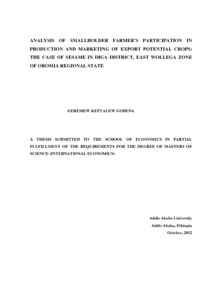Resource information
Agriculture in Ethiopia remains to be the key sector. It is still the main source of foreign exchange earnings (up to 90%) and the largest labour force employer (about 83%). Of the total agricultural output, about 95% was covered by smallholder agriculture sub-sector. However, a number of factors limit smallholder farmers from participating in export potential cash crops. The main objective of this paper is to identify household specific factors determining sesame production and marketing participation. The study was based on data collected from a sample of 120 households drawn from Diga Wereda.
The study highlighted that farm landholding size, family labour, number of oxen owned, access to credit, availability of family food, and distance to extension service significantly explain the decision to produce sesame. On other hand, the number of oxen owned, farmers experience on sesame production, number of working family members, sesame crop yield and access to credit service determine the level of sesame production participation considerably. Furthermore, the study verified that in addition to the quantity of sesame marketed, market price, selling channels, selling time, distance from the nearest market and access to market information significantly determines the level of income earned from sesame sale. The implication is that livelihood improvement could be assisted through better participation of smallholders in sesame production and marketing in the area.



